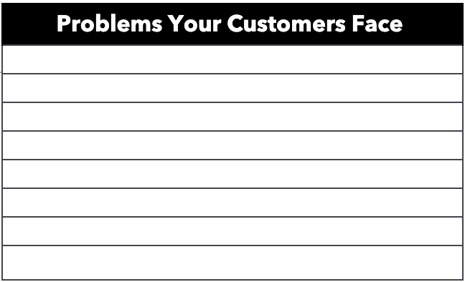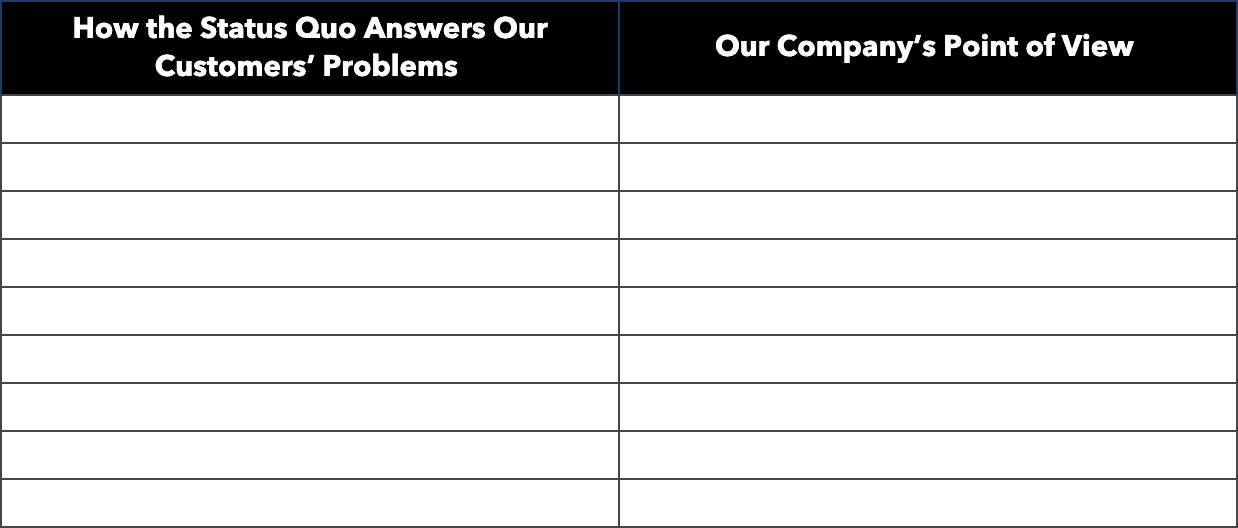
The Leadership Message – Attracting Prospects Through a Point-of-View
By Austin LaRoche, ATAK Interactive CEO
Leadership belongs to those who take it.
–Sheryl Sandberg
Any business can pay to attract consumers. If you want 1 million eyeballs on your website tomorrow, you can pay a nice offshore company to make that happen. Sure, your site probably wouldn’t be able to handle the volume of users and crash, but you get the point. Attracting is easy because attracting can be purchased.
Getting real traction, converting someone driving down the highway who sees your billboard or is interrupting your social media feed to take an action, well that’s a little more difficult.
People pay all sorts of money in hopes of attracting and converting. They pay writers to publish content. They pay PR companies for media attention. They pay SEO agencies for more organic traffic to their website. They pay media buyers to place ads in front of their target audience. They pay salespeople to call, email, and knock on doors of prospects they have never met to tell them about their service and product.
And yet, the outcome many desire from these purchases does not come to fruition. And I can tell you why…
Communication lacks the impact needed to make someone change.
In other words, there’s a leadership void in the message and nothing you are saying is unique, interesting, or persuasive.
Let’s use an Accounting Firm as an example. We’ll call them, The Smith Company. It’s September and they want to build some marketing campaigns for the next 6-8 months leading up to Tax Day. They take out the checkbook and start writing checks to:
• A writing service that produces content
• An SEO agency
• A local PR agency
• 2 new salespeople
Alright, The Smith Company is ready to invest in its growth.
Now comes the moment of truth.
Each of these people, whether an agency or an in-house hire, is going to have a preliminary meeting where they ask the accountants in some way, shape, or form: “Tell us about yourself and what makes you different.”
Going back to the old Sinek Golden Circle video, we can assume their answer will touch upon the what and the how of what they do. If they’re like many of the accountants I’ve run into over the years, they will plug the same type of “value propositions” that aren’t really value propositions.
“Our people are the best! We put service first! We are super experienced and have seen it all! We listen to our customer! We are nice and fair and please, pretty please, come with us!”
So let’s now put ourselves in the shoes of the new people on the project. We’ve got 3 new agencies on board and 2 new employees and all they have to work with is customer service and experience? They are doomed to fail.
The content company will inevitably write the same educational resources anyone can find on Wikipedia and content farms. The PR company will pitch them for pay-to-play “awards” that don’t really mean anything and hope they don’t notice the lack of media placements. The SEO team will optimize for the same keywords as the other accounting firms in town with no tools to get an advantage. And the Sales Team is going to knock on doors hoping some sweet old lad or lass is lonely and needs someone to talk to.
Now let’s say this wasn’t the case. Let’s say The Smith Company’s, CEO, Roy Smith, took his 20+ years of professional experience, considered the new tax laws, thought about the problems his customers were facing and expressed something completely unique, intelligent, and valuable.
In this hypothetical, our pal Roy takes his time and works with each of the new vendors and their employees and explains to each of them that there are “7 Opportunities the 2019 Tax Laws Present for Homeowners.” He goes into detail about each.
Now we have new resources that can perform:
The content company has something unique to put together. They can create flexible content across blogs, videos, infographics, and more.
The PR team has something they can pitch to media outlets with more of a readership as an editorial placement. Additionally, there’s an opportunity to get local media gigs around tax season with the new message.
The SEO team can get more backlinks because the content is compelling and unique enough to be shared.
And the Sales Team has helpful information for prospects that they will be able to use when evaluating if it’s time for them to make a change.
Marketing + Sales run much more effectively when a company has a valuable and unique message. But how do you craft that message? What factors need to be considered?
Let me show you 😉
How to Craft the Perfect Leadership Message for Your Organization
Step 1: Identify the Problems Your Customers Face

The best way you can show value to someone is to put yourself in their shoes. By showing empathy towards your target market, it’s easier to connect the dots in how the products or services you offer can help them.
Step 2: Identify the Emotion That Will Create Change
Dr. Paul Ekman categorizes the “Atlas of Emotions” in human beings as such:
- Anger
- Fear
- Sadness
- Disgust
- Joy

If those sound familiar to you, perhaps this is where I should note that Ekman was a key advisor on the hit Pixar film, “Inside Out,” where all five of these emotions lived inside the mind of a little girl.
Now there’s a lot of derivatives of these emotions, even by Ekman himself. In the 90s, he expanded his work to include the following as our “basic emotions”:
Amusement, Contempt, Contentment, Embarrassment, Excitement, Guilt, Pride in Achievement, Relief, Satisfaction, Sensory Pleasure, and Shame.
From a marketing perspective, the complete range of emotions is a better group to work from, but we still need to trim it down a bit:
- Anger
- Fear
- Sadness
- Disgust
- Joy
- Amusement
- Contempt
- Contentment
- Embarrassment
- Excitement
- Guilt
- Pride in Achievement
- Relief
- Satisfaction
- Sensory Pleasure
- Shame
What emotions above do you want your message to invoke in your target audience? In the end, you most certainly want some form of joy. But how do you get there?
In the example above with The Smith Company’s “7 Opportunities the 2019 Tax Laws Present for Homeowners,” they are eliciting a feeling of excitement. There’s a possibility on the horizon. There’s a new path that makes it possible to save money. Who’s not excited by that?
Conversely, a terrible computer virus may be going around that infects users of a popular software program. An IT company may want to step in with a fear-based approach, “4 Must-Have Security Features to Protect Your Computer from the Y Virus”. Obviously, the end result of their work would be “relief,” but to provoke change, the company needs to instill a sense of fear in the customer so they know just how serious the cost of inaction may be.
Now it’s your team’s turn. Take the list of emotions above and pull out the top five best possibilities. Put them aside for a minute. We will be coming back to these.
Step 3: Misconceptions + Differentiators
To lead, you must say and do something new. Leading is for the creatives. The explorers. The risk takers.
To create a leadership message, you have to put yourself out there. You no longer need to try to appeal to anyone and everyone. You’re going to appeal to a target customer that needs what you offer the way you offer it.
You can’t say something new, however, without identifying a) what is currently considered the status quo and b) how you or your company break through and do things differently. See the chart below:

On the left-hand side, identify the different ways your competitors and industry are commonly attacking the problems you outlined in step 1. For each of these problems, consider how you will do it differently.
Note that you can’t take this part of the exercise in a completely black and white fashion. If you’re a plumber, there are only a few ways to get a clogged toilet working again. However, you can recognize that most of your competitors believe in “being there when you need it”. They focus a lot of marketing efforts in search, where their target market goes when something has gone wrong. From there, the plumber could say that the Status Quo solves the problem of a clogged toilet once the toilet is clogged. However, you could constantly be marketing the proactive ways in which you will avoid needing a plumber to come out for a clogged toilet.
What?!?! But wouldn’t you lose business if everyone knew not to throw 45 sheets of teepee down the toilet at once? Sure, you’d lose some of that money if people got themselves into shape. However, when the time came for you to install a new bathroom in the house, who would you go to? The guy who came out and fixed your toilet 4 times or the person who taught you how to not clog the toilet? You’re going with the person that has shown they have your best interest at heart.
All this potty talk aside, you get the point. If everyone’s zigging, you either need to zag or learn how to zig better than everyone else.
Start by bringing up the things that drive you crazy about your competitors. What are they doing that you believe is either wrong or not as effective as your way? This should get you going in the right direction to fill out each side of the chart.
- Remember, for every little thing that “grinds your gears,” needs to be an avenue where you can do it better/differently.
Step 4: Bring it All Together
Okay, you’ve now identified a lot of different elements we need to thread together:
- The Problems Your Customers Face
- The Emotion(s) You Believe with Create Change
- What the Status Quo is Doing
- What You are Doing Differently
How do these come together into a clear message?
- Start with value. You’ve identified the problems. What would be the most valuable thing you could give to a prospect to assist with that problem and earn yourself trust and credibility?
- Next, consider the emotions you narrowed down in Step 2. To get your target to actually pay attention and receive this value you’re hoping to provide, how do you need to make them feel?
- With the value and emotions considered, how do you say something completely unique and different to them? Where do you bring in this unique point-of-view you’ve outlined?
- How do you put all of these elements together and draw in your target customer through enticing communication related to the emotion you are hoping to elicit?
If you answered these questions and haven’t been able to put together your message, try this simple formula:
(#) + (Adjective) + (Nouns) That (Can Solve a Common Problem)
For example:
- 7 Profitable Opportunities the 2019 Tax Laws Present for Homeowners
- 4 Must-Have Security Features to Avoid the Y Virus
- 5 Little-Known HR Dangers That Will Get You Sued
- 3 Packaging Myths Holding Companies Back
- 6 Customer Demands Transforming Contract Manufacturing
One last caveat. If you use this formula, you BETTER back up the promise of your title with original, interesting, and VALUABLE content. Do not put together the same old listicle that everyone else has pumped out. This formula often leads to a catchy title with no substance added thereafter. Whatever route you take, make sure you fulfill the promise of your premise. Otherwise, this piece of content you’ve built to attract your target audience will have the opposite impact. To showcase leadership, you must lead. Say something new, or risk being looked at as an “also-ran.”
How to Disseminate Your Leadership Message
Alright, you’ve got your message together. It provides original ideas and educational value to your target market. Now comes the last part – how do you disseminate the message?
Like many parts of the PMM, you are going to need to rely on your understanding of the target audience to some extent. If your dream customer only shows up to certain industry events, then perhaps your Leadership Message should be displayed as an interactive keynote that you would present at an event. If your ideal customer is going to search google to solve this problem, a blog post or video might be the route.
This illuminates one of the great aspects of the Leadership Message: it allows you to make flexible, consistent content. Once you have the central message you want to use to attract your audience, it can be created as a video, presentation, blog post, editorial on another site, speech, infographic, cold call, or anything else that’s applicable.
By creating the message first, you create content that feeds into those initiatives we outlined above. Start with your unique perspective, and let the SEO, PR, and Sales efforts amplify it thereafter.
Related Posts

Marketing Strategy Agency Derivatives and Growth Unlocked
Marketing is an essential aspect of any business. It can help increase brand awareness, attract new customers, and drive sales. However, developing an…

Boosting ROI: Benefits of Hiring a Marketing Strategy Agency
Are you looking for ways to enhance your marketing strategy and increase your returns? Look no further than Derivatives, a top-tier marketing strategy…

The Role of a Web Design Agency in Boosting Your Online Presence
We examine the field of web design and the work of web designers in this blog. It takes a variety of talents, including graphic design, coding, and user…